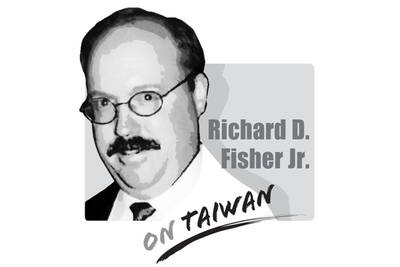Since Taipei Mayor Ko Wen-je (柯文哲) officially split with the Democratic Progressive Party (DPP) in late May, increasing uncertainty in the Nov. 24 mayoral election, there has been ample speculation and a myriad of predications about what will happen.
Some have speculated that Ko could form an alliance with smaller parties, such as the New Power Party (NPP) or the People First Party (PFP), to boost his electoral prospects, considering that he is an independent without any party resources, while DPP mayoral candidate Pasuya Yao (姚文智) might share the green-leaning voter base with him.
Such speculation appears to have some merit, given Ko’s appearance at a campaign event last week held by PFP Taipei city councilors Lin Kuo-cheng (林國成) and Hung Shih-chi (洪士奇), who are also seeking re-election.
Some have even tossed around the idea of Ko teaming up with PFP Chairman James Soong (宋楚瑜) for the 2020 presidential race, something the mayor has dismissed as “too soon to tell.”
Talk about the possibility of Ko running for president is nothing new. It has periodically been discussed since the physician-turned-politician emerged from the 2014 mayoral race as a ray of hope for the nation’s two-party system, with its never-ending bipartisan conflict and hurdles to the adoption of new policy.
The presidency has only ever been held by the DPP and the Chinese Nationalist Party (KMT), and no independent or small-party candidates have broken the trend.
Although a non-partisan politician winning the presidency could signal that the nation’s democratic system has matured, whether it would be a good idea and whether Soong would be Ko’s ideal right-hand man is debatable.
First, the 113-seat Legislative Yuan has long been dominated by the KMT and the DPP. Even though smaller parties win seats from time to time, the number they hold is usually too small to make a real difference in day-to-day operations.
If history has shown anything, it is that a president can hardly get anything done without a legislative majority, at least not in a society as politically polarized as Taiwan’s.
Former president Chen Shui-bian (陳水扁) of the DPP is a perfect example. Both of his presidential terms were overshadowed by a KMT-dominated legislature, which saw to it that none of Chen’s policies would clear the legislative floor without a fight — sometimes literally.
Now imagine what the situation would be like if Ko was elected president. He would have few allies in the legislature, unless the DPP was willing to put aside its hypothetical failure in the presidential race and prioritize the nation’s development over its chances of defeating Ko in the subsequent presidential election.
Second, although Ko and Soong appear to share some similar ideas when it comes to cross-strait relations — such as the notion that the “two sides of the Taiwan Strait are one family” — Ko would hardly project an image of success and a bright future if he teamed up with Soong, given that the latter has a record number of four failed presidential bids under his belt.
Ko seems poised to be re-elected as Taipei mayor, with a poll published on Wednesday by Chinese-language Web site Credere Media putting him in a comfortable lead over the other two candidates, but whether his popularity in a single city could be translated into nationwide support remains to be tested.
Before that happens, any talk of him running in the 2020 presidential race is premature.

On Sept. 3 in Tiananmen Square, the Chinese Communist Party (CCP) and the People’s Liberation Army (PLA) rolled out a parade of new weapons in PLA service that threaten Taiwan — some of that Taiwan is addressing with added and new military investments and some of which it cannot, having to rely on the initiative of allies like the United States. The CCP’s goal of replacing US leadership on the global stage was advanced by the military parade, but also by China hosting in Tianjin an August 31-Sept. 1 summit of the Shanghai Cooperation Organization (SCO), which since 2001 has specialized
In an article published by the Harvard Kennedy School, renowned historian of modern China Rana Mitter used a structured question-and-answer format to deepen the understanding of the relationship between Taiwan and China. Mitter highlights the differences between the repressive and authoritarian People’s Republic of China and the vibrant democracy that exists in Taiwan, saying that Taiwan and China “have had an interconnected relationship that has been both close and contentious at times.” However, his description of the history — before and after 1945 — contains significant flaws. First, he writes that “Taiwan was always broadly regarded by the imperial dynasties of
A large part of the discourse about Taiwan as a sovereign, independent nation has centered on conventions of international law and international agreements between outside powers — such as between the US, UK, Russia, the Republic of China (ROC) and Japan at the end of World War II, and between the US and the People’s Republic of China (PRC) since recognition of the PRC as the sole representative of China at the UN. Internationally, the narrative on the PRC and Taiwan has changed considerably since the days of the first term of former president Chen Shui-bian (陳水扁) of the Democratic
A report by the US-based Jamestown Foundation on Tuesday last week warned that China is operating illegal oil drilling inside Taiwan’s exclusive economic zone (EEZ) off the Taiwan-controlled Pratas Island (Dongsha, 東沙群島), marking a sharp escalation in Beijing’s “gray zone” tactics. The report said that, starting in July, state-owned China National Offshore Oil Corp installed 12 permanent or semi-permanent oil rig structures and dozens of associated ships deep inside Taiwan’s EEZ about 48km from the restricted waters of Pratas Island in the northeast of the South China Sea, islands that are home to a Taiwanese garrison. The rigs not only typify